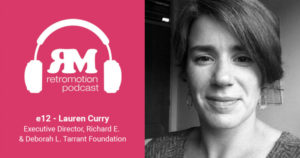Contributed by Lauren A. Curry.
This foundation cares about a lot of things. Recognition isn’t one of them. Why? “Because,” my boss would tell you, “this isn’t about us.”
Look around Vermont, in fact, and you’ll find buildings and facilities given in honor of other people – people who perhaps don’t have the means to make a “naming” contribution themselves, but who have given deeply of their passion and their labor. Naming buildings after folks like that is our way of celebrating those gifts, and of staying true to our core belief that no amount of money can have an impact without the people who do the real work at the community level.
But that’s a different story.
Today I’m thinking about another side of donor recognition. And I’m wondering if we – the philanthropic community – have been getting it wrong all along? And if, in doing so, we’re undermining the true nature of what philanthropic relationships are supposed to be about?
Here’s the problem. Last week I walked up to the post office and collected my typical pile of stuff: urgent notices about my (non-existent) business cable account, yet another IRS acknowledgement of our change of address three years ago, checks from our board treasurer, a couple of glossy non-profit magazines, and a stack of newsletters and annual reports.
As you’d expect, we get marketing pieces from all the non-profits to which we’ve written a check this year. And last year. And really ever. Some are slick and expensive, others about as homemade as you can imagine. In virtually every one, there’s that ubiquitous, clunky, tree-killing feature of the non-profit landscape: the donor acknowledgement list.
Please don’t tell my boss, but I actually read those lists. If we’ve given a gift recently, I check to be sure we’re listed and listed correctly. If we’re not, I drop a friendly, hey-this-really-isn’t-a-big-deal-but note to the organization to get the issue resolved.
Mind you, I hate writing those notes. I used to be in charge of donor lists when I worked for a community foundation out west. Whether compiling or just editing them, those lists pretty much never left our office without my initials on them somewhere. And I sweated those lists hard. I read them and read them and re-read them. I checked and double-checked. More than a decade later I can still tell you the correctly spelled names of a whole bunch of people I never even met. (Bet you can too.)
But mistakes inevitably happened, and the error notices came to me. So any time I have to alert a grantee now to an acknowledgement issue, it’s done with legitimate empathy.
The error I found last week was completely understandable. It happened because we’d made a complicated gift that wasn’t easily tracked in a database. The gift came as a mix of direct, indirect and in-kind support, conveyed over multiple years. I can only imagine the challenge of tracking each component for tiered recognition by fiscal year.
That’s the thing, though. Why try?
More and more we’ve come to understand that philanthropy is a long-term game, and that donor relations unfold over lifetimes – even beyond. Our Foundation certainly considers our non-profit partners to be long-term allies, and we view our investments as having a compounding effect.
So what does it tell donors when support is acknowledged strictly within an arbitrary date range? What does it suggest when thank you lists reset to zero each year, and support that may have built up over decades is functionally swept aside?
There are of course accounting realities and operating budgets that open and close on fixed dates. But that’s where I think we get into trouble: building donor recognition – better yet donor engagement – scenarios based on financial management tools.
I’m not suggesting that non-profits publish forever-additive lists. Perish the thought. But it does strike me that in as much as non-profits want to forge sustained relationships with donors – and vice versa – consideration of new systems of acknowledgement is warranted.
I’m imaging what my personal donor profile at my favorite non-profit might look like if it were structured to focus and build on the full history of our relationship. It’s a relationship that goes back to my early 20s, and includes years when even tiny gifts meant sacrifice. The few occasions when I didn’t send my check within their non-calendar fiscal year, my name was of course omitted from the published list.
Makes me wonder what the marketing of such a list is really intended to encourage. Is it motivating me to rush my gift in before the wonky fiscal year cut-off? I’m not sure. Right now I’m feeling something far less inspirational … like it reveals fickleness in a relationship I consider enduring. Certainly there’s a bit of a what-have-you-done-for-me-lately flavor in it.
Of course the answer isn’t for non-profits to acknowledge donors who don’t give. But perhaps it is to forgive the occasional lapse, and publicly thank donors anyway for being part of a philanthropic movement that helped get the organization where it is today. Or maybe, for groups using a tiered acknowledgement system, it’s to orient those systems in a way that values a donor’s lifetime commitment to the cause, not a snapshot.
My boss, while not a fan of me spending time on donor recognition issues, is a fan of getting to the bottom line. So here it is:
Let’s acknowledge donor support as something deeper and with far broader a horizon than a fiscal year could justly describe.
Lauren A. Curry has been the Executive Director of the Richard E. and Deborah L. Tarrant Foundation since 2005.




 @tarrantgiving
@tarrantgiving